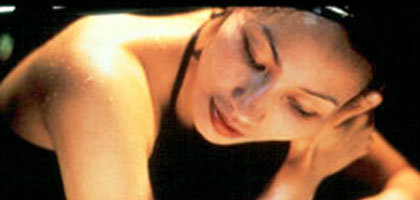
At the Height of Summer

Synopsis
Our synopses give away the plot in full, including surprise twists.
Hanoi, the present. Lien (Trân Nû Yên Khê), the youngest of three sisters, works in the café run by her eldest sister Suong (Nguy Nhû Quynh) and shares an apartment with their brother Hai (Ngô Quang Hâi), an aspiring actor. On the fourth anniversary of their mother's death Lien, Suong and the middle sister Khanh (Lê Khanh) gather at the café to prepare dishes for the memorial ceremony and reception. While they work, Suong's photographer husband Quoc (Chu Hûng) shows his work to Khanh's husband Kien (Trân Manh Cuông), a writer having trouble finishing his novel. Later the sisters discuss the idea their mother had a lifelong crush on a classmate.
Quoc leaves on a field trip to a remote bay - where he is reunited with a woman who has borne his son. He resolves to tell Suong at last about his second family. Meanwhile Suong herself meets a secret lover in the afternoons. On a trip to Saigon Kien is attracted to the glamorous Ngan (Doan Viét Ha); aware of his interest, she invites him to her hotel room at night. Lien, whose relationship with Hai verges on the incestuous, looks for a potential husband who resembles her brother; but Hoa (Lê Vu Long), the boy she likes best, is turned off by her domineering character.
Quoc tells Suong about his lover. She is initially distraught but soon proposes an accommodation: he can keep his second family as long as he remains a husband to her. Khanh finds a note from Ngan in the pocket of Kien's jacket, but says nothing. Lien scares her sisters by suggesting that she's pregnant - with no foundation. One month after the commemoration of their mother's death, they prepare to mark the anniversary of their father's death.
Review
Born in Vietnam but educated in France, Tran Anh Hung uses his dual-culture identity more productively than any other émigré Asian film-maker. His Vietnam films, balanced between romanticised memories from his childhood and present-day social observation, are so deeply rooted in the culture - so at ease with it - that they could never have been made by a foreigner. But Tran's way of thinking about characters and relationships, his fetishistically precise imagery and his elliptical narrative structures are all quintessentially French. The two strands meshed to fascinating effect in The Scent of Green Papaya (1993) and Cyclo (1995), but At the Height of Summer is a slightly less satisfying hybrid: a film in which the strain of imposed ideas begins to show.
The film's central concern is clear, and clearly eastern: it's about 'face', the primary need to maintain appearances no matter what disruptive currents run beneath them. It's also a film about sexuality in a Confucian climate: the unequal struggle between libidinous impulses and the superego, which demands a façade of harmonious propriety. The theme emerges naturally enough from the plotting (the film offers a panorama of adulteries, all of them hushed-up to preserve the image of harmony) but Tran characteristically uses a symbolic mystery to frame his analysis. The action spans the month between the anniversaries of the deaths of two parents; the punctilious observance of the dates and ceremonies, like the matching portraits symmetrically hung above the family altar, represents both Confucian orthodoxy and the integrity of the family. Early in the film, though, Tran plants the suggestion that the sisters' late mother may have had a lover named Toân - and shows the sisters running for cover in the thought that the man was more likely an adolescent crush than an adult affair.
Since the idiom is anything but social realist, the plotlines unfold in sequences of limpid artifice. The setting is a largely imaginary Hanoi with brief interludes in Saigon (a luxury hotel) and the countryside (a pristine bay with a wise old fisherman, a village clearing scenically dotted with grazing water buffalo). The apartment of Suong's lover is a symphony of drapes, veils and objets d'art; the spacious apartment shared by Lien and Hai is a virtual gallery of neo-primitive paintings by Tran Trong Vu. Even the interior of a Vietnam Airlines plane is modernised and gentrified. It's hard to be sure why the film is so determined to give its characters lifestyles so redolent of the Parisian bourgeoisie. Is Tran again countering western expectations of 'Third World cinema'? Is he placating the Vietnamese authorities by over-compensating for the depictions of squalor in Cyclo? Or is he tapping into a Sirk/Fassbinder tradition by dramatising emotional problems in terms of material well-being?
Whatever, the film is at its weakest whenever it succumbs to the same designer tendencies in the scripting of individual scenes. Suong's wordless afternoon liaisons with her lover are mannered and unconvincing, while Lien's equally silent break-up with a potential boyfriend (both of them in virginal white) seems ludicrously contrived. Conversely, the film is most assured and affecting when it allows its actors' faces and bodies to articulate the heart's filthy secrets without needing to detach them from the rhythms and cadences of everyday life. And many of Taiwanese cinematographer Mark Lee's individual images are powerful and resonant, from close-ups of water on hair and skin in the tropical heat to the vignettes of Kien at his low table trying to deal with writer's block.
Although the film has a very keen sense of female solidarity and complicity, it's ultimately obsessed with the conundrum of heterosexual relations as experienced in a culture which considers it 'ignoble' for a woman to touch a man's head but quite OK for her to touch his penis. Beneath the placid facades of married life it finds knots of frustration, desire, impotence and castration-wishes. The entire schema is brilliantly sketched in the opening scene: Hai, the marginalised (and presumably gay) brother, wakes and starts working out while Lien sleepily taunts and flirts with him, eventually stepping on his six-pack, the whole choreographed to Lou Reed singing 'Pale Blue Eyes'. It's the best scene of its kind since Jane Russell sang 'Anyone Here For Love?'.
Credits
- Director
- Trân Anh Hûng
- Producer
- Christophe Rossignon
- Screenplay
- Trân Anh Hûng
- Director of Photography
- Mark Lee
- Editor
- Mario Battistel
- Production Designer
- Benoît Barouh
- Music
- Tôn Thât Tiêt
